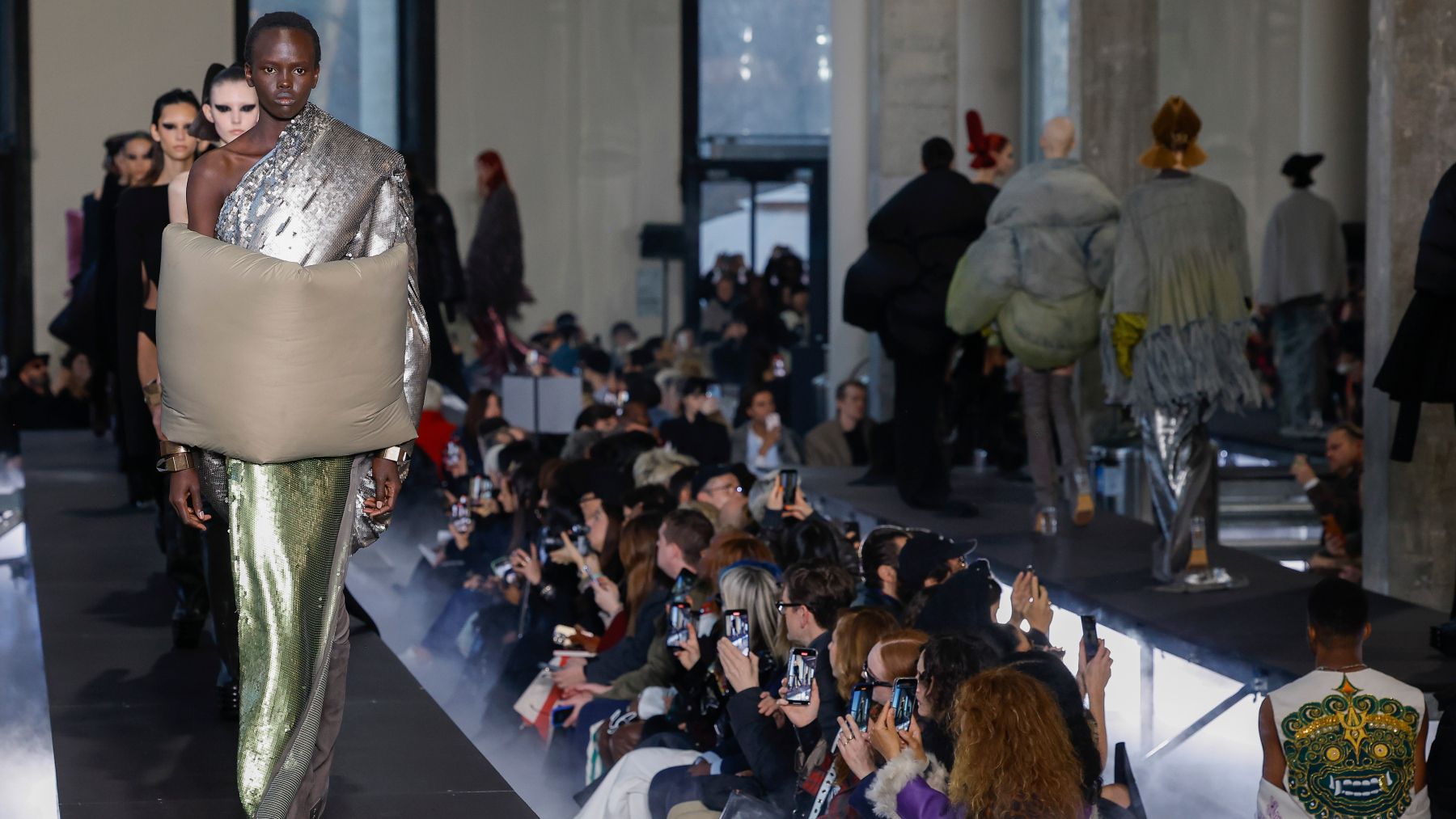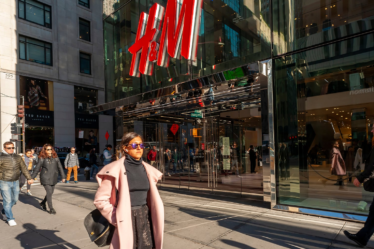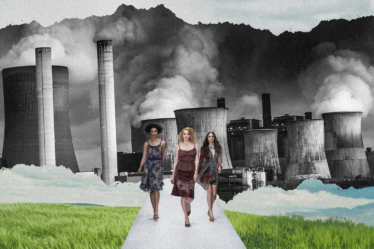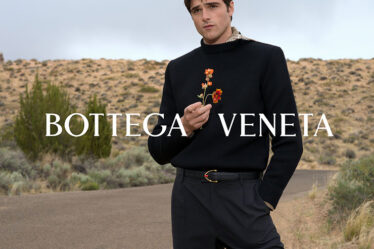
PARIS — “Some designers sugarcoat everything and that’s a valid thing, but I’m more of a neo-realist,” Rick Owens was in a reflective mood before his show on Thursday. “I need to see the gorgeousness and the horror of the world because that’s the human condition, and that’s what we all have to wrestle with. So I think it’s more of a realistic gesture.”
The collection he was about to show certainly had the gorgeousness. “I went on a sequin orgy,” confessed Owens. There were coils of them around model torsos, pavés of them on puffer jackets and tunics, handfuls of them strewn through capes of shredded denim. There were also slinky knit goddess dresses trailing serpentine trains, and duchesse satin shrouds rising into points that created an eerie closeup-ready frame for the face. It may have been the most mutant version of Old Hollywood’s outré glamour that Owens has ever offered, but it was glamour nonetheless.
As for the horror? Its presence was more abstract. On the anniversary of Vladimir Putin’s misbegotten invasion of Ukraine, Owens was confronted by the challenge of how to present a fashion collection. Every day, we see the dignity of people in the face of adversity. He felt his response needed to be, in his words, “respectful and responsible.” He’s usually drawn to the chaotic and the unkempt. Now, he felt the more appropriate response was something more formal, earnest even, however uncool that might sound. We’ve never seen hair and makeup so stylised from Owens. Some of stylist Duffy’s hair confections were as structured as a principessa’s from alta moda Roma. That might have seemed counter-intuitive when the world is closer to a nuclear apocalypse than at any time since Owens started staging shows that did actually seem to anticipate apocalypse. His answer? “I’ve done post-apocalypse, it’s the opposite now. I want something a lot more polished, more deliberate.” I get it. When chaos prevails, order represents defiance.
Maybe that was one reason his shownotes scrupulously detailed the origin and treatment of his fabrics, with a strong emphasis on responsibility. Petra, his granddaughter, was backstage in the arms of her mother Scarlet. Maybe that’s what it takes these days to remind a designer of the impact of their business. (Babies in the vicinity induced the same realisation in Lagerfeld and Armani.) “There have been times when I felt darker, for sure,” Owens conceded, ”but now there is a level of acceptance I’m noticing in myself. I’m finding a different kind of serenity.” It showed in the clothes, in a new spirit of formality and structure. There’s reassurance in those notions, and that was something else that nuzzled at the edges of this collection. Just look at the lucite-heeled boots that have become cultural signifiers for a global kickass collective. Now they’ve got “duvet padding.”
Formality was also the keynote of Daniel Roseberry’s first ready-to-wear show for Schiaparelli. When he offered his earliest couture confections for the house, I was on my hind legs wondering how they might work for ready-to-wear. Making the World Surreal with Schiap! Obviously, the collection couldn’t be as extreme as couture. Roseberry emphasised that this new collection was less about fantasy, more about the Schiap woman in the here and now. Still, he did a pretty good job of reproducing his Schiap’s extravagant spirit for the wider platform of ready-to-wear. He claimed that had a lot to do with the fact that he went back to the very foundation of the house, Elsa Schiaparelli herself. “The way she dressed, the turbans, the way we styled the bijoux, it all came from photographs from the 1930s,” said Roseberry. “It was almost like a security for me.” He also said he’d been obsessed with the new documentary series “Kingdom of Dreams,” with its depiction of the fashion industry in the 1990s when creativity could fuel commerce, rather than the inverse which prevails now. “That show left me so supercharged.”
And there was a third driving force: the clients who insist on something exotic, precious, unique. For instance, the woman who wanted a down jacket that wasn’t as mass as Moncler. Roseberry offered her a huge, feather-filled parka in black satin with the big gold nipple buttons that tell the world you’re wearing SCHIAP! A denim jacket and jeans (and, man of the people that I am, it was the denim I was keenest to see) were zhooshed with anatomical gold buttons. Something as straightforward as a double-breasted cashmere coat could also be transfigured with a dozen or so of those fasteners. And the sleeves of a coat in black velvet chenille were embroidered with golden beads.
So it was, after all, extravagance that shaped Schiap’s ready to wear. It wasn’t merely the gleam of gold. There were faux Astrakhan and snow leopard jackets, quilted stretch satin skirts, and an intense, artisanal hand-painted theme in coats and jackets (it will be stencilled for scaling up at the production facilities in Italy.) The keyhole motif, a Schiap emblem, appeared at the heart of a draped black jersey dress. A black leather suit was trimmed in the brass measuring tape that is another key motif for the house. The capper for the whole exercise might have been Irina Shayk’s duvet coat in champagne-coloured silk satin. “The great thing is we don’t really have a price limit so we can go really far,” said Roseberry. That coat had already made his point.



